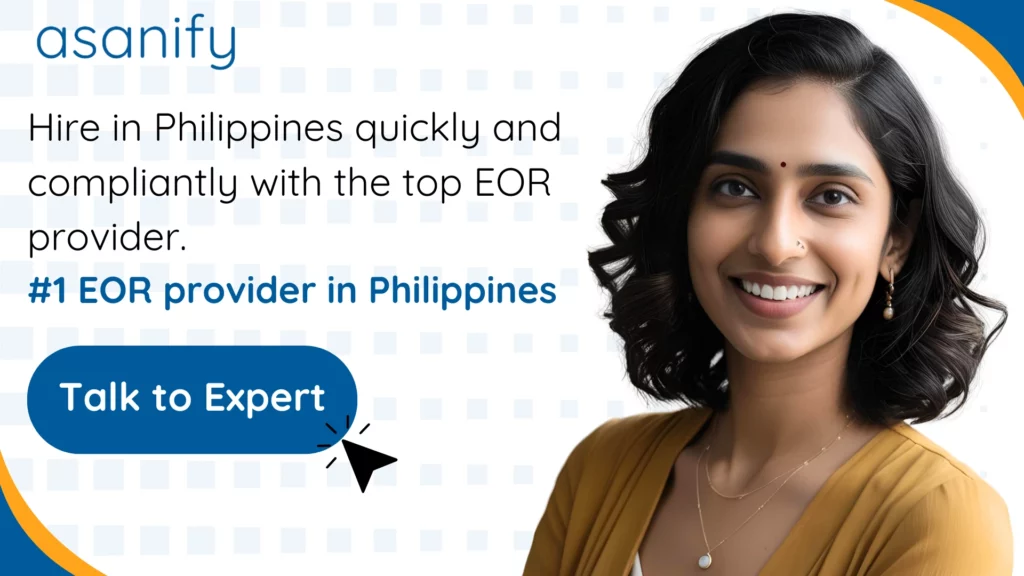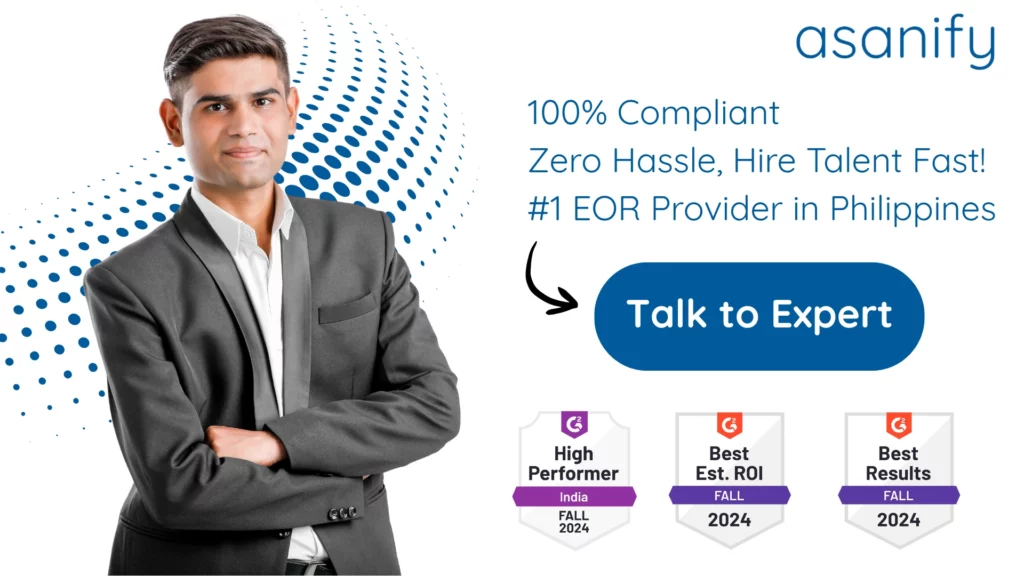The Philippines is one of Southeast Asia’s fastest-growing economies, known for its skilled workforce, strategic location, and strong business process outsourcing (BPO) and service sectors. Its competitive labor market, English proficiency, and pro-investment environment make it an appealing hub for global companies looking to hire in the Philippines. Bringing in foreign professionals adds specialized expertise and global perspectives that enhance the local talent pool, and partnering with an Employer of Record can make the hiring process faster, compliant, and more efficient.
However, employing non-Filipino nationals requires strict compliance with the country’s immigration and labor rules. Businesses must secure the correct work permits and visas before foreign hires can start work. The process involves multiple agencies, specific documentation, and set timelines. Staying compliant helps avoid penalties and ensures smooth onboarding, enabling international employees to contribute quickly and effectively.
Table of Contents
- Overview of the Philippines’ Work Permit and Visa System
- Understanding Requirements and Eligibility
- Types of Work Visas and Permits in the Philippines
- Advantages of the 47(a)(2) Visa
- Application Process for Employers
- Required Documents
- Processing Timelines
- Employer Responsibilities and Compliance
- Maintaining Ongoing Compliance
- Tips for a Smooth Application Process
- How an Employer of Record Can Help
- How Asanify Can Help
- FAQs
Overview of the Philippines’ Work Permit and Visa System
Philippines has a clearly defined system for managing foreign employment, which is based on the worker’s qualifications, job category, and intended length of stay. All foreign nationals must follow a formal process to obtain the necessary work authorization before beginning employment in the country.
Key points:
- Philippines citizens – No work permit required.
- Foreign nationals – Must secure a work permit and corresponding visa before starting work.
- Tiered classification system – Applicants are categorized into Class A, B, or C permits based on skill level and role.
- Employer-driven applications – Employers initiate the process by obtaining a Notification Letter of Foreigner’s Work Permit before the employee applies for a visa.
- Two-step process – First, secure the work permit; second, apply for the Z visa and convert it to a residence permit after arrival.

Understanding Requirements and Eligibility
Before starting the application process, both employers and employees must understand Philippines’s foreign employment regulations. All non-Filipino nationals require a valid work permit and corresponding visa to work legally in the country, with requirements varying based on job classification, the worker’s qualifications, and the permit category. Philippines’s tiered system—Class A, B, and C assigns eligibility criteria depending on skill level, experience, and the type of role, making it essential for both parties to meet the specific conditions for the intended employment.
Who Needs a Work Permit in the Philippines
All non-Filipino nationals intending to work whether as employees, managers, consultants, or technical experts must secure an Alien Employment Permit before beginning work. This is regardless of whether they are employed by a local company or a foreign entity operating in the country.
Key Conditions for Obtaining a Work Visa
To qualify for a Philippine work visa, applicants generally must:
- Have a job offer from a Philippine-based employer.
- Possess the skills or expertise relevant to the role.
- Meet DOLE qualifications for the position.
- Maintain a clean criminal record.
- Be medically fit for employment.
Employer and Employee Eligibility
Employers must show that the position cannot be easily filled by a Filipino worker. Employees must meet job-specific skill or educational requirements, which vary by industry and role.
Suggested Read: Understanding Labour Laws in the Philippines in 2025
Types of Work Visas and Permits in the Philippines
- 9(g) Pre-Arranged Employment Visa – For foreign nationals with an approved AEP, allowing them to work for a specific employer.
- Special Non-Immigrant Visa (47(a)(2)) – For employees of PEZA or BOI-registered companies, often with streamlined processing.
- Alien Employment Permit (AEP) – Mandatory for all foreign employees, issued by DOLE.
- Special Work Permit (SWP) – For short-term assignments of up to 6 months.
Comparing Work Permit Types
| Permit Type | Purpose | Duration | Notes |
| Alien Employment Permit (AEP) | DOLE-issued permit to work in PH | 1–3 years | Prerequisite for work visa |
| 9(g) Work Visa | Long-term employment with a local employer | 1–3 years | Requires AEP |
| Special Non-Immigrant Visa 47(a)(2) | Work in PEZA/BOI-registered companies | Variable | Often faster processing |
| Special Work Permit (SWP) | Short-term employment | Up to 6 mos | No AEP required |

Advantages of the 47(a)(2) Visa
The 47(a)(2) Visa provides faster processing, fewer documentation requirements, and eligibility for employees in priority sectors such as IT, manufacturing, and export services. It is especially beneficial for companies operating in economic zones with investment incentives.
Application Process for Employers
- Apply for the Alien Employment Permit (AEP) at the DOLE Regional Office where the company is based.
- Secure the 9(g) or 47(a)(2) Visa from the Bureau of Immigration once the AEP is approved.
- Submit supporting documents such as the employment contract, passport copies, and clearances.
- Pay government fees for both the AEP and the work visa.
Required Documents
- Duly accomplished AEP application form.
- Copy of valid passport with visa pages.
- Notarized employment contract.
- Company registration documents (SEC/DTI, Mayor’s permit).
- Recent passport-sized photos.
- Proof of tax identification number (TIN).
- For 47(a)(2) visas, PEZA/BOI endorsement letter.
Processing Timelines
- AEP issuance – Around 2–3 weeks.
- 9(g) Visa processing – 1–3 months after AEP approval.
- SWP processing – Within 5–10 working days.
Employers should plan for 1–3 months total lead time before the employee can legally start work.
Employer Responsibilities and Compliance
Employers hiring foreign nationals in the Philippines must:
- Ensure the role cannot be filled by a qualified Filipino.
- Maintain valid AEPs and visas for all foreign staff.
- File renewals before expiry.
- Report terminations or role changes to DOLE and the Bureau of Immigration.
Penalties for non-compliance include fines, possible deportation of employees, and restrictions on future hiring of foreign staff.
Legal Obligations
Employers sponsoring foreign workers must:
- Provide legally compliant employment contracts.
- Pay salaries meeting or exceeding Philippines legal or regional standards.
- Enroll employees in social insurance and housing fund schemes (where applicable).
- Keep detailed records of work status and permit validity.
- Renew work and residence permits before they expire.
Consequences of Non-Compliance
Failure to comply with Philippines’s immigration and labor laws can lead to:
- Heavy fines and administrative penalties.
- Possible revocation of the right to hire foreign employees.
- Deportation of the employee.
- Reputational damage and operational disruption.
Maintaining Ongoing Compliance
- Keep detailed HR records of permit and visa validity.
- Monitor deadlines to avoid lapses.
- Update government agencies on employment status changes.

Tips for a Smooth Application Process
- Start the process early to avoid onboarding delays.
- Double-check requirements for DOLE and the Bureau of Immigration.
- Engage professional assistance or an Employer of Record (EOR).
How an Employer of Record Can Help
Partnering with an Employer of Record in Philippines allows companies to legally employ foreign talent without the need to establish a local legal entity. The EOR acts as the official employer, managing payroll, social insurance contributions, benefits, HR compliance, and immigration procedures. This approach reduces administrative burdens, accelerates hiring timelines, and ensures full compliance with national and regional labor regulations.
Additionally, EOR providers prepare employment contracts that comply with Philippines labor laws, minimizing the risk of legal disputes. They also handle the complete work permit and visa application process, coordinating with local authorities to ensure smooth onboarding for international employees. By leveraging an EOR in Philippines, businesses can focus on growth and operations while leaving complex employment compliance in the hands of local experts.
Suggested Read: How to Hire a Remote Team in the Philippines in 2025
How Asanify Can Help
Navigating Philippines’s work authorization process can be challenging, particularly for businesses hiring international talent. Asanify offers a comprehensive Employer of Record (EOR) solution that streamlines hiring and workforce management in Philippines.
Our services cover every stage from securing the correct work permits and visas to processing payroll, social insurance, and employee benefits ensuring you remain compliant with Philippines labor laws without the need to set up a local entity.
With Asanify, you can:
- Hire and onboard foreign talent quickly without administrative delays.
- Ensure compliance with all national and regional labor and immigration regulations.
- Expand into Philippines without the cost and complexity of establishing a local company.
If your goal is to grow your team in Philippines efficiently, Asanify’s expertise and end-to-end services make the process smooth and fully compliant.
FAQs
Typically 1–3 years, depending on visa type, with renewals allowed.
The AEP is issued by DOLE and is a prerequisite for the 9(g) Visa, which allows work and residence.
No, SWPs are for short-term work and do not require an AEP.
Yes, dependents may apply for appropriate visas.
An EOR ensures compliance, accelerates hiring, and removes the need to set up a legal entity.
Not to be considered as tax, legal, financial or HR advice. Regulations change over time so please consult a lawyer, accountant or Labour Law expert for specific guidance.

